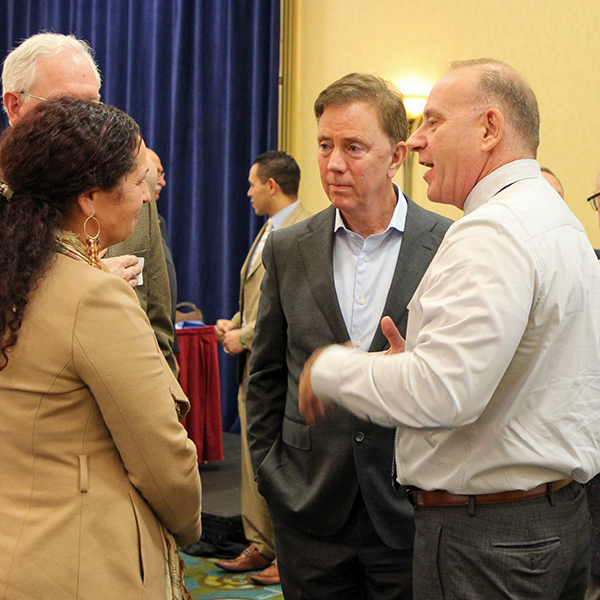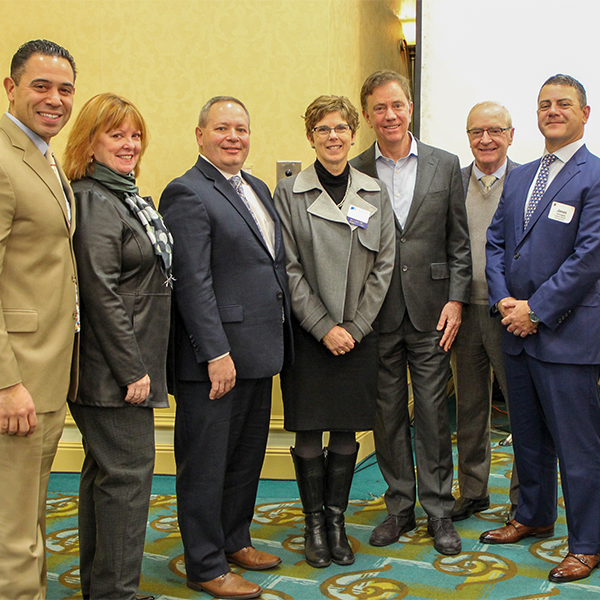Growth, opportunity and the importance of planning for the future. Governor Ned Lamont and speakers at the Business Breakfast on December 3 conveyed a decidedly optimistic view of our economic future, particularly in eastern Connecticut. That optimism rests squarely on addressing issues that could impede growth: transportation, energy, and workforce.
The Chamber of Commerce of Eastern CT and the Greater Mystic Chamber of Commerce welcomed Governor Lamont to speak about his plans for the State and our region and address questions from representatives from industry leaders, small businesses, and nonprofits. The morning was sponsored by Coastal Wealth Management, Mashantucket Pequot Tribal Nation/Foxwoods, Norwich Public Utilities and UCFS Healthcare. Norwich Mayor Peter Nystrom welcomed 130 attendees on a snowy day to the Holiday Inn in Norwich.
Jason Cerniglia, of Coastal Wealth Management, set the positive tone by sharing their view of a continuing strong market, a disconnect with forecasts of a slowing economy. “The economy is actually doing quite well: GDP growth is at 2.1%, unemployment is still at historical lows, and we’ve got a very accommodating federal reserve in that interest rates are staying, and probably will stay, low for the foreseeable future.”

Governor Lamont picked up on that theme, particularly as it pertains to our region. “I am not allowed to invest anymore, but if I was, I’d be investing in eastern Connecticut…you really have such economic momentum,” said Lamont, citing Electric Boat’s securing the largest maritime award for shipbuilding in the history of the Navy at $22 billion. He focused on the stability this multi-year contract affords, with plans to hire 1000 people each year over several years into good paying jobs.
Having a trained workforce is essential to this economic growth, said the governor. The creation of the Governor’s Workforce Council includes a manufacturing czar and a platform for business and academia to communicate about programs that meet workforce needs with creative strategies to meet the needs of industry and small manufacturers over the next five to ten years. With tens of thousands of jobs unfilled the relationship with the technical schools and community colleges is essential. “This is a real elevator that could lift people up and make sure nobody is left behind,” said the governor.
On the strength of the job market, Governor Lamont added, “This is an amazing time to upgrade our housing stock and invest in downtown Norwich, Groton and New London and bring those cities to life.” Norwich Public Utilities’ Chris LaRose expressed their commitment to supporting this type of economic growth.
Contributing to economic growth in New London, Lamont cited the opportunity with wind power and State Pier, starting with a collaborative agreement with Orsted and neighbors in New London harbor. “At the end of the day, it would be transformative.” In addition to hundreds of jobs, wind power provides “good clean renewable power that we control” with prices locked in for the next 10 to 20 years. The Governor also commented on the relationship with Millstone which was solidified early in his administration, ensuring the power plant’s operation as a carbon-free option through the 2020’s.

Governor Lamont turned his speech to tourism as “another unsung major industry,” where he worked to increase funding in a tough budget cycle. The focus is on leveraging marketing dollars to get the message out. He sees tourism as being valuable beyond immediate returns as “it reintroduces the state of Connecticut to a new generation,” bringing young people to experience the state where there are jobs and excellent educational opportunities waiting for them.
Rodney Butler, Chairman of the Mashantucket Pequot Tribal Nation, raised the impact of transportation issues on tourism and economic growth in his remarks introducing the governor. Relying on safe transportation for employees and visitors, the tourism economy depends on this essential function of government. “Whether you agree with tolling or not we should all be thankful to the governor for shining a bright light on the need to fix our ailing transportation infrastructure,” said Butler.
The critical issues around transportation are acknowledged by all parties in Hartford, according to the governor. The disagreement is about how to fund repairs on structures like the Gold Star Bridge. He noted the importance of not raiding the rainy-day fund or incurring excessive debt to achieve infrastructure improvements. The $2.5 billion rainy-day fund is the largest in the state’s history and will allow Connecticut to weather a moderate to severe recession and maintain fiscal stability.
Questions from the audience raised concerns about proposed tolling on trucks, and its potential spread to include cars or exceed the limited timeline. Lamont defended the importance of developing a revenue stream while making adjustments so local businesses would not be hit with tolls more than once each day. With the unpopularity of tolling, Lamont suggested it would not easily be expanded.

Transportation improvements include improving railway service and experience throughout the state. GMCC President Peggy Roberts asked about increased rail stops in Mystic, to which the governor responded enthusiastically.
The crux of the state’s future success, according to Lamont, is economic growth. He recruited the roomful of people to represent the state to incoming businesses. “There’s nobody better able to sell the state of Connecticut,” said Lamont. “Tell them the good and bad about Connecticut, but emphasize the good, if you would.” Calling out the state for being a “laggard” over the past generation, he pointed to growth sectors including small business, advanced manufacturing, life sciences and biotech, and digital media.
Governor Lamont noted the private-public relationship in his administration. Bringing people with private industry experience into the public sector, he hopes to spur economic growth, evaluate state offices and employ technological solutions, and reduce the time it takes for businesses to move through the regulatory process. Jennifer Granger, of UCFS Healthcare, presented in her remarks a reflection of that approach in the nonprofit sector, with fully integrated services and electronic records that seamlessly transition patients from location to location, and soon, to major healthcare systems in the state.


